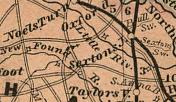


 |
 |
C&O Milepost 111.8
Station Number: 112
Code Number: 0168
Tel. Calls: HN
 Doswell was originally known as Hanover Junction (though I’ve also seen it
called Sexton’s Junction on Lloyd’s
Official Map of Virginia from 1861. Click the link, search for Virginia, and then search in the page for Lloyd’s).
The name was changed to Doswell in the early 1890’s in honor of Major Thomas Doswell. The first
Doswell in the area was James Doswell, a captain in the American Revolution. After
the war he returned to his estate, named Bullfield, to raise fine horses. His
descendants continued to raise excellent race horses and, as long as racing was legal
in Virginia, the Doswell track was well attended. One of James’ descendants,
Major Thomas Doswell, fought in the Civil War. After the War, he carried on the
family tradition as a breeder of fine race horses. He also owned a hotel (see below)
to put up railroad travelers and an excelsior plant. The Doswell home still stands on
the West side of U.S. Route 1, about a mile from the station.
Doswell was originally known as Hanover Junction (though I’ve also seen it
called Sexton’s Junction on Lloyd’s
Official Map of Virginia from 1861. Click the link, search for Virginia, and then search in the page for Lloyd’s).
The name was changed to Doswell in the early 1890’s in honor of Major Thomas Doswell. The first
Doswell in the area was James Doswell, a captain in the American Revolution. After
the war he returned to his estate, named Bullfield, to raise fine horses. His
descendants continued to raise excellent race horses and, as long as racing was legal
in Virginia, the Doswell track was well attended. One of James’ descendants,
Major Thomas Doswell, fought in the Civil War. After the War, he carried on the
family tradition as a breeder of fine race horses. He also owned a hotel (see below)
to put up railroad travelers and an excelsior plant. The Doswell home still stands on
the West side of U.S. Route 1, about a mile from the station.
Construction of the Piedmont Sub (as the Louisa Railroad) began in Doswell with a connection to the RF&P. In 1850, the Virginia Central (formerly the Louisa Railroad) desired their own line into Richmond. The RF&P fought the extension, claiming that their charter gave them exclusive access to Richmond from the north. The Virginia courts disagreed. From that time on the C&O’s single track mainline crossed the double track main of the RF&P in Doswell. At first, wooden gates protected the crossing; trains had to stop and open the gates before they could proceed. A Virginia law also required that trains stop and verify that the way was clear before passing through the crossing. The RF&P installed a mechanical interlocking at the crossing in 1904, electro-automatic semaphore signals in 1913, and color-light signals in 1927. At that time, the junction was guarded by HN Tower, built in 1929, which was staffed by the RF&P. Both roads, however, paid the salaries. The tower was retired in September of 1958. From then on the C&O’s mainline was controlled from Richmond.
The C&O and the RF&P also maintained a joint passenger station at Doswell. The original depot was destroyed during the Civil War and was replaced by a temporary building (described as “commodious”) and water station. In 1870 a permanent station was built that was itself replaced in 1907 with a station that, to my eyes, bore a family resemblance to the station at Gordonsville. The C&O retired the stock pen in Doswell in 1926. The wooden station burned in 1927. Sanford Terry, resident of the area, writes, “I rode my bicycle to Doswell to view the smouldering ashes. Nothing was left of the old building except two brick chimneys.” The burned station was replaced by the red brick, Georgian style one pictured below. By 1970 passenger trains only stopped at Doswell with advance warning from the station agent. Outbound freight traffic in 1970 was mostly pulpwood and wood chips. A veneer company and an excelsior plant were located in Doswell.
Photos |
This is the C&O/RF&P station in Doswell. At one time it was in use by CSX as offices. I assume that the Buckingham Branch still uses it as office space. This image is from a postcard dated 1983. (From a postcard in the collection of Larry Z. Daily)
[NEW] A relatively short C&O passenger led by E8 4028 passes the Doswell depot in 1956. Note that the E8 still has the front coupler covers. Those were later removed from all the E8’s. I’m surprised by how open the country is in the background of this photo. By the time I was visiting the area in the 1990’ the background was filled with tall trees. (Photographer unknown. From a slide in the collection of Larry Z. Daily)
The eastbound Sportsman passes Doswell in the early 1960’s. (Jack Spangler photo. Used with permission.)
Train number 41 The George Washington passes the Doswell station sometime in 1966. (Photographer unknown. From a slide in the collection of Larry Z. Daily)
A C&O freight train led by a mix of GP7’s and GP9’s rumbles past the depot in Doswell. The date is July 19, 1969 (Photographer unknown. From a slide in the collection of Larry Z. Daily.)
This is the same train as in the previous photo. Newly rebuilt caboose 3515 brings up the rear. (Photographer unknown. From a slide in the collection of Larry Z. Daily.)
The train is rolling off into the distance, revealing details of the track and the area around the depot. (Photographer unknown. From a slide in the collection of Larry Z. Daily.)
This image is from a 1971 photo I acquired on eBay. (Photographer unknown. From a photo in the collection of Larry Z. Daily.)
The Doswell depot on August 21, 1977. (Photographer unknown. From a slide in the collection of Larry Z. Daily. )
A Chessie work train led by GP9 6249 passes the Doswell station heading east through the diamond. (Date unknown, Keith Buckley photo, used with permission)
The Doswell depot in August of 1983. The trim looks like it has been freshly painted. (Photo by Tom Baldner. From a slide in the collection of Larry Z. Daily.)
[NEW] Another photo of the Doswell depot in August of 1983. (Photo by Tom Baldner. From a slide in the collection of Larry Z. Daily.)
The Doswell depot on the first of July in 1986. (Photo by Sam Bone. From a slide in the collection of Larry Z. Daily.)
The Doswell station area looking north up the RF&P main in May of 1987. (Photo by Norman Blackwood. From a slide in the collection of Larry Z. Daily.)
A streetside shot of the Doswell depot in June of 1989. This photo was taken at the same time and most likely by the same person as the two June of 1989 photos of HN cabin below. (Photographer unknown. From a slide in the collection of Larry Z. Daily.)
This is the only image of the Doswell freight house that I own and it’s the best one I’ve seen. The label on the back says that it was taken on July 2, 1971. (Photographer unknown. From the collection of Larry Z. Daily.)
This photo shows HN cabin. It’s from a slide dated August 21, 1977. I suspect that it was taken by the same person who took the photo of depot on the same date. (Photographer unknown. From a slide in the collection of Larry Z. Daily.)
This image was taken in 1983. This is the north side of the building. The RF&P mainline is to the right and the Piedmont Sub is in the background. (Photographer unknown. From a slide in the collection of Larry Z. Daily.)
This image was also taken in 1983 and shows the east or track side of the building. (Photograph by by Tom Baldner. From a slide in the collection of Larry Z. Daily.)
This photo shows HN cabin with the C&O / RF&P crossing in the foreground. It was taken at the same time as the June 1989 photo of the depot above. (Photographer unknown. From a slide in the collection of Larry Z. Daily.)
The folks in the background of this image suggest that there was some type of railfan event or some special movement occurring. Given where they're standing, whatever it was was most likely on the RF&P. (Photographer unknown. From a slide in the collection of Larry Z. Daily.)
HN Cabin on October 18, 1995. (Photograph by H. E. Brouse. From a slide in the collection of Larry Z. Daily.)
The single track line is the former C&O mainline and the double track is the former RF&P line. (November 2001 photo by Larry Z. Daily)
This is a shot of the abandoned excelsior plant in Doswell. Excelsior is a shredded wood packing material made from pine and it provided a substantial part of Doswell’s economy in prior times. (1998 photo by Larry Z. Daily)
This is all that remained of the gravel loading ramp in Doswell when I visited in 1999. As far as I can tell, dump trucks backed up a ramp on the other side of this retaining wall and dumped their loads into waiting hoppers. (1999 photo by Larry Z. Daily)
Major Doswell ran a hotel near the railroad. According to my sources, that hotel later became a general store. The antique store in the top photo, which is located near the RF&P tracks across from the station, was once a general store. As a result, for some time I thought that it may have been Doswell’s hotel. Several people, however, suggested that I was wrong and one of them pointed to the structure in the next photo. I have to admit, that one does look more like a hotel to me. (1999 photo by Larry Z. Daily)
Jack Bruce alerted me to what he thought looked like a set of old bridge abutments just east of Doswell. He suggested that, perhaps, the line used to run slightly south of its current location. After visiting the area, I have to agree. The old roadbed was even more apparent given the high water levels from heavy rains that fell shortly before my visit. The C&O Valuation maps confirm that the track was realigned in August, 1947. This photo was taken facing west towards Doswell. (2002 photo by Larry Z. Daily)
Maps |
Stations |
|
You are visitor number
to this site since the new counter was inaugurated on June 28, 2004.
This site was originally established in 1997.
| Mail comments to: | Larry Z. Daily |
Please note that, due to a huge volume of spam coming in on my email account, I’ve had to change my email address. The new address is lzdaily@nospam.piedmontsub.com (but remove the nospam and the dot before piedmontsub.com).
Copyright © 1997-2025 Larry Z. Daily. All rights reserved.
All materials on this Web site are protected by United States
copyright law. This includes, but is not limited to, articles and graphics. Unless
otherwise indicated, these materials are the property of Larry Z. Daily and may not
be used without prior written permission of Larry Z. Daily